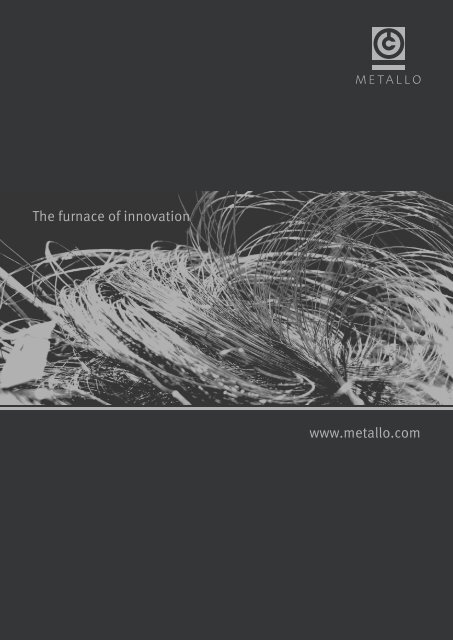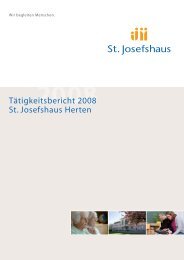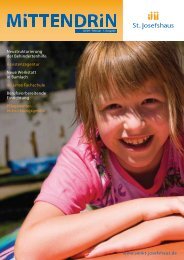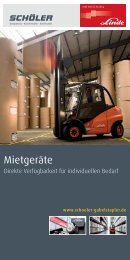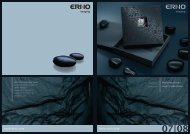Produkte - Kommunikation & Design
Produkte - Kommunikation & Design
Produkte - Kommunikation & Design
Sie wollen auch ein ePaper? Erhöhen Sie die Reichweite Ihrer Titel.
YUMPU macht aus Druck-PDFs automatisch weboptimierte ePaper, die Google liebt.
The furnace of innovation<br />
www.metallo.com
The furnace of innovation
Preface 05 Vorwort<br />
09 Rohstoffe<br />
Raw materials<br />
Products 13 <strong>Produkte</strong><br />
Sustainability 17 Nachhaltigkeit<br />
Recycling and refining<br />
07 Recycling und Raffination<br />
Raw materials<br />
11 Rohstoffe<br />
Products 15 <strong>Produkte</strong><br />
Preface<br />
Vorwort<br />
Highest level set-up of pyro- and<br />
hydro metallurgical processes<br />
Metallo excels in multi-metal recycling and refining of non-ferrous metals.<br />
Over 90 years of experience resulted in the highest level set-up of pyro- and<br />
hydro metallurgical processes which can treat the most complex secondary<br />
raw materials and refine them into new metal products to supply the metal<br />
consuming industry.<br />
The best available technologies, mostly invented and created by our own<br />
engineers, give Metallo a unique position in the world in the valorisation of metal<br />
and metal compounds. And we continue to feed our “Furnace of Innovation”,<br />
both through the use of ever more complex raw materials as well as through new<br />
technological ideas on the refining processes. Being the “smelter for smelters”.<br />
Ausgereifte pyro- und hydrometallurgische Verfahren<br />
Metallo ist Spezialist für Multi-Metall-Recycling und Raffination von<br />
Nichteisen metallen. Mit mehr als 90 Jahren Erfahrung und ausgereifter pyround<br />
hydro metallurgischer Verfahren ist Metallo in der Lage, durch Aufbereitung<br />
komplex ester Sekundärrohstoffe neue Metallprodukte für die metallverarbeitende<br />
Industrie herzustellen.<br />
Die besten verfügbaren Technologien (Best Available Technologies ‚BAT‘), die<br />
mehrheitlich von den Ingenieuren unseres Hauses erfunden und entwickelt<br />
wurden, verschaffen Metallo weltweit eine einzigartige Position in der Verwertung<br />
von Metall und Metallverbindungen. Darüber hinaus beschicken wir ständig<br />
unseren „Furnace of Innovation“ – und zwar sowohl durch den Einsatz immer<br />
komplexer werdender Ausgangsmaterialien als auch durch neue technologische<br />
Impulse für die Raffinationsprozesse. Dabei fungieren wir als „Schmelzwerk der<br />
Schmelzwerke“.<br />
Being the smelter<br />
for the smelters.<br />
A leading company in the<br />
non-ferrous metal sector<br />
05<br />
Metallo belongs to the Metallum Holding<br />
S.A. – a holding company founded in 2007,<br />
with head quarters in Luxembourg. The Group<br />
is active worldwide and is divided into the<br />
two sectors foundries/smelters and trade/<br />
recycling.<br />
The Group recycles, processes and sells about<br />
1,000,000 tonnes of metals annually.<br />
In Europe the Metallum Holding belongs<br />
to the leading companies in the non-ferrous<br />
metals sector. The Group employs<br />
approximately 800 people.<br />
Ein führendes Unternehmen<br />
im Buntmetallsektor<br />
Die Metallum Group gehört der Metallum<br />
Holding S.A. an – einer Holdinggesellschaft,<br />
welche 2007 gegründet wurde, mit Hauptsitz<br />
in Luxemburg. Die Gruppe ist weltweit tätig<br />
und teilt sich in die zwei Sparten Gießereien/<br />
Hütten und Handel/Recycling.<br />
Die Gruppe recycelt, verarbeitet und verkauft<br />
jährlich circa 1‘000‘000 Tonnen Metalle.<br />
In Europa gehört die Metallum Holding zu den<br />
führenden Unternehmen im Buntmetallsektor.<br />
Die Gruppe beschäftigt ca. 800 Mitarbeitende.
Recycling and refining<br />
Recycling und Raffination<br />
Essential for industrial society<br />
Non-ferrous metals are indefinitely recyclable without loss of<br />
quality. Metallo’s technologies are mainly based on cost and<br />
energy efficient pyro metallurgical processes. Over 350,000<br />
tonnes of raw materials are annually fed to the processes to be<br />
recovered into marketable metals.<br />
Within the smelting and refining process four main steps can<br />
be defined:<br />
Smelting<br />
The smelters treat all secondary raw materials with a relatively<br />
low copper, tin or lead content through reduction. This reaction<br />
produces metal called black copper which is still an impure<br />
copper containing +/- 80 % Cu and taking along Sn, Pb, Ni<br />
and its accompanying elements.<br />
Converting<br />
The liquid or granulated black copper along with other cold<br />
charges of copper scraps and alloyed materials is fed into the<br />
convertor furnaces. In this phase the copper is separated from<br />
most other metal components before being cast into anode<br />
moulds.<br />
Distillation<br />
The tin department treats the crude solder alloy coming from<br />
the foundry, and all other types of tin bearing raw materials. In<br />
the first stage of this process, the greater part of the lead in the<br />
alloys is evaporated into a soft lead and cast into 25 kg ingots.<br />
The remaining lead is removed to produce pure tin ingots with<br />
a lead content below 100 ppm, possibly even down to 50 or<br />
below 25 ppm of lead.<br />
Refining by electrolysis<br />
The copper anodes produced in the foundry are refined into<br />
copper cathodes by means of electrolysis. The nickel units left<br />
in the anodes find themselves back in the electrolyte and are<br />
converted into nickel briquettes at the nickel department.<br />
07<br />
The furnace of innovation.<br />
Unentbehrlich für die Industriegesellschaft<br />
Nichteisenmetalle sind unbegrenzt ohne Qualitätsverlust<br />
recycelbar. Die von Metallo eingesetzten Technologien basieren<br />
primär auf kosten- und energieeffizienten pyrometallurgischen<br />
Verfahren. Mehr als 350.000 Tonnen Ausgangsmaterial werden<br />
jedes Jahr den Prozessen zur Gewinnung vermarktbarer Metalle<br />
zugeführt.<br />
Innerhalb des Schmelz- und Raffinierprozesses lassen sich<br />
folgende vier Hauptprozesse abgrenzen:<br />
Der Schmelzprozess<br />
In den Schmelzöfen entsteht aus allen Sekundärrohstoffen<br />
mit einem relativ geringen Kupfer-, Zinn- oder Bleigehalt durch<br />
Reduktion so genanntes Schwarzkupfer bei dem es sich<br />
noch um unreines Kupfer bestehend aus einem Kupferanteil<br />
von +/-80 % und Sn, Pb, Ni sowie Begleitelementen handelt.<br />
Der Konverterprozess<br />
Das flüssige oder granulierte Schwarzkupfer wird zusammen<br />
mit Kupferschrott und legierten Zuschlägen in einen Konverterofen<br />
gefüllt, wo das Kupfer von den meisten anderen Metallen<br />
abgeschieden und zu Anodenplatten vergossen wird.<br />
Der Destillationsprozess<br />
Die Zinnanlage verarbeitet die Blei-Zinn-Legierung aus der<br />
Gießerei, aber auch andere zinnhaltige Rohstoffsorte. Zuerst<br />
wird der Großteil des Bleis in der Legierung zu Weichblei<br />
kondensiert, das in Blöcke zu 25 kg gegossen wird. Das<br />
restliche Blei wird entfernt, so dass reine Zinnblöcke mit einem<br />
Bleigehalt von unter 100 ppm, eventuell sogar unter 50 oder<br />
25 ppm, entstehen.<br />
Die elektrolytische Raffination<br />
Die in der Gießerei erzeugten Kupferanoden werden in der<br />
Elektrolyse zu Kupferkathoden weiterverarbeitet. Das im<br />
Anodenkupfer enthaltene Nickel reichert sich im Elektrolyten<br />
an und wird in der Nickelanlage zu Nickelbriketts verarbeitet.
Raw materials<br />
Rohstoffe<br />
Secondary raw material feed<br />
Metallo uses both metallic as well as oxidic secondary raw<br />
materials to feed its furnaces, or a combination of both.<br />
Materials are sourced through the entire supply chain, from<br />
metal merchants, scrap and waste processors to industry itself,<br />
which generates production scrap or by-products and wastes<br />
through companies’ own processes.<br />
Typical examples of raw materials are:<br />
Copper tubes, wire and sheets<br />
Birch Cliff or Nr 2 copper scraps<br />
Yellow & red brass pieces, turnings, powders<br />
Ocean or car radiators<br />
Shredder fractions from electronic shredding facilities<br />
Copper and copper/lead granules from cable granulating<br />
Cu-Fe (shredded) armatures<br />
Electric motors<br />
Copper, brass or tin plated iron foils, sheets, pieces<br />
Copper and copper alloy coins, or plated coins<br />
Copper, tin and lead bearing runouts, drosses, ashes,<br />
fumes, sludges<br />
Copper cements<br />
Lead scrap<br />
09<br />
With the recycling of<br />
scrap and waste, Metallo<br />
makes an important contribution<br />
to environmental protection.<br />
Sekundärrohstoffe als Ausgangsmaterial<br />
Metallo verwendet für die Beschickung der Öfen entweder<br />
metallische oder oxidische Sekundärrohstoffe oder eine<br />
Mischung aus beiden Rohstoffarten.<br />
Das Ausgangsmaterial stammt dabei aus allen Stufen des<br />
Metallkreislaufs: von Metallhändlern, über Schrott- und<br />
Abfallverwerter bis hin zur Industrie, in der Produktionsabfälle<br />
und Nebenprodukte in den eigentlichen Fertigungsprozessen<br />
der Unternehmen entstehen.<br />
Typische Ausgangs materialien:<br />
Kupferrohre, -drähte und -bleche<br />
Kupferschrott Birch Cliff oder Nr. 2<br />
Messing- und Rotgussstücke, -späne, -pulver<br />
Gemischte Autokühler (Ocean)<br />
Schredderfraktionen aus Elektronik-Schredderanlagen<br />
Kupfer- und Kupfer/Blei-Granulate aus Kabelgranulierungen<br />
Cu-Fe-Armaturen (geschreddert)<br />
Elektromotoren<br />
Kupfer-, messing- oder zinnbeschichtete Eisenfolien,<br />
-bleche, -stücke<br />
Kupfermünzen, Münzen aus Kupferlegierungen<br />
und verkupferte Münzen<br />
Kupfer-, zinn- und bleihaltige ausgelaufene Metalle,<br />
Krätzen, Aschen, Abgase, Schlämme<br />
Kupferzemente<br />
Bleischrott
Raw materials<br />
Rohstoffe<br />
Preparing the feed<br />
Upon receipt of the materials, loads are first checked visually. In accordance with<br />
suppliers’ requirements, samples are taken for chemical assaying in trust or in<br />
the presence of a neutral surveyor. After performance of quality evaluation and<br />
the supplier’s agreement on the assays, material is released for production feed.<br />
Some qualities of scrap need specific treatment prior to feeding. Some are baled<br />
by means of hydraulic balers; other qualities are cut into manageable pieces by<br />
means of scrap shears. If necessary, slag is broken into smaller fragments.<br />
Copper and tin ashes and residues are dried in a drying installation and<br />
separated into a fine (< 1 mm) and a coarse fraction. The fine fraction is stored in<br />
silos and pneumatically injected into the melting bath of the furnaces. The coarse<br />
fraction is mixed with the other raw materials to prepare the furnace charges.<br />
Each furnace charge is a mixture of different kinds of raw materials. A distinction<br />
is made between three kinds of furnace charges, because the processing starts<br />
at different stages:<br />
Vorbereitung des Ausgangsmaterials<br />
Nach Eingang der Rohstoffe werden diese zunächst einer Sichtkontrolle<br />
unter zogen. Entsprechend den Anforderungen der Lieferanten werden Proben<br />
für eine chemische Analyse genommen, die von uns auf Vertrauensbasis oder im<br />
Beisein eines neutralen Gutachters durchgeführt wird. Nach der Qualitätsbeurteilung<br />
und der Genehmigung der Ergebnisse durch den Lieferanten, wird das<br />
Ausgangs material für die Beschickung der Öfen freigegeben.<br />
Einige Schrottqualitäten müssen vor der Beschickung noch speziell aufbereitet<br />
werden. So werden einige Qualitäten mit hydraulischen Paketierpressen zu<br />
Paketen verpresst; andere wiederum mit Schrottscheren in handliche Stücke<br />
geschnitten. Schlacke wird bei Bedarf in kleinere Teile gebrochen.<br />
Kupfer- und Zinnaschen und -rückstände werden in einer Trocknungsanlage<br />
getrocknet und in eine feine (< 1 mm) und eine grobe Fraktion getrennt.<br />
Die feine Fraktion wird in Silos gelagert und pneumatisch in das Schmelzbad<br />
der Öfen eingebracht. Die grobe Fraktion wird mit anderen Einsatzstoffen<br />
für die Beschickung gemischt.<br />
Die Beschickung der Öfen erfolgt chargenweise. Jede Ofencharge besteht aus<br />
einer Mischung verschiedener Einsatzstoffe. Dabei werden nach dem jeweils<br />
verarbeiteten Ausgangsmaterial drei Arten von Ofenchargen unterschieden:<br />
A passion for metals.<br />
11<br />
A “poor” charge, i. e. a furnace charge<br />
containing only relatively low-grade and<br />
mainly cupriferous raw materials, usually<br />
of an oxidic nature (copper ashes and slag,<br />
Cu/Fe scrap, etc.).<br />
A “rich” charge, i. e. a furnace charge that<br />
only consists of high-grade copper raw<br />
materials, usually of a metallic nature<br />
(copper scrap, gun metal, radiators, etc.).<br />
A “lead/tin” charge, i. e. a furnace charge<br />
that only consists of specific tin- and<br />
lead-bearing raw materials.<br />
Eine „arme” Charge ist eine Ofencharge,<br />
die ausschließlich aus relativ minderwertigen,<br />
überwiegend kupferhaltigen<br />
und i.d.R. in Oxidform vorliegenden<br />
Einsatzstoffen (z. B. Kupferasche und<br />
-schlacke, Cu/Fe-Schrott etc.) besteht.<br />
Eine „reiche” Charge ist eine Ofencharge,<br />
die ausschließlich aus hochwertigen, i.d.R.<br />
in Metallform vorliegenden Kupferwerkstoffen<br />
(z. B. Kupferschrott, Rotguss, Kühler<br />
etc.) besteht.<br />
Eine „Blei/Zinn”-Charge ist eine Ofencharge,<br />
die ausschließlich aus bestimmten<br />
zinn- und bleihaltigen Einsatzstoffen<br />
besteht.
Products<br />
<strong>Produkte</strong><br />
Metallo produces metals like copper, tin, lead and nickel.<br />
Residues are sold for further refining. Metamix is the final slag,<br />
mainly used in construction or as raw material for the cement<br />
industry.<br />
Copper<br />
Copper Blister – To customer’s specifications<br />
Copper Anodes – To customer’s specifications in the specific<br />
format for tankhouse feed<br />
Copper Cathodes – In addition to the high grade copper<br />
cathodes brand ‘SME’, registered on the London Metal<br />
Exchange, Metallo also offers standard grade cathodes<br />
with min. 99.95 or 99.97 % Cu.<br />
Tin<br />
High grade tin ingots with min. 99.93 or 99.95 % Sn guaranteed<br />
are registered on the London Metal Exchange as the ‘MC’ brand<br />
and are well known for the low level of lead content, below<br />
100 ppm or even down to 50 or 25 ppm.<br />
Lead<br />
Soft lead ingots with min. 99.9 % Pb content as well as hard<br />
lead ingots with varying contents from 3 up to 15 % of antimony<br />
can be offered.<br />
Copper, tin and lead.<br />
13<br />
Metallo gewinnt Metalle wie z. B. Kupfer, Zinn, Blei und Nickel.<br />
Dabei entstehende Rückstände werden zur weiteren Raffination<br />
verkauft. Das Schlackenendprodukt Metamix wird vor allem als<br />
Baumaterial und als Ausgangsstoff für die Zementherstellung<br />
verwendet.<br />
Kupfer<br />
Blisterkupfer – nach Kundenspezifikation<br />
Kupferanoden – nach Kundenspezifikation im geeigneten<br />
Format für die Elektrolyse<br />
Kupferkathoden – Neben unseren hochwertigen Kupferkathoden,<br />
die an der Londoner Metallbörse unter der Marke ‚SME’<br />
gehandelt werden, bieten wir auch Standardqualitätskathoden<br />
mit min. 99,95 bzw. 99,97 % Cu an.<br />
Zinn<br />
Unsere hochwertigen Zinnblöcke mit einem garantierten<br />
Zinngehalt von min. 99,93 bzw. 99,95 % werden an der<br />
Londoner Metallbörse unter der Marke ‚MC’ gehandelt und<br />
zeichnen sich durch ihren geringen Bleigehalt von unter<br />
100 ppm und sogar unter 50 oder 25 ppm aus.<br />
Blei<br />
Im Sortiment sind Weichbleiblöcke mit einem Bleigehalt von<br />
min. 99,9 % sowie Hartbleiblöcke mit einem Antimon-Anteil<br />
von 3 bis 15 %.
Products<br />
<strong>Produkte</strong><br />
Tankhouse Slimes<br />
The slimes generated in the tankhouse are sold for further<br />
refining of the precious metals in specialised industries.<br />
Zinc oxide<br />
The zinc oxide generated during the smelter processes is sold<br />
to zinc refining companies.<br />
Nickel<br />
Nickel is recovered as electrolyte for the production of nickel<br />
sulphate or as metal in the form of briquettes with min. 90 %<br />
nickel content for the stainless steel industry or as an alloy<br />
component.<br />
Metamix<br />
The final slag, which is basically an iron silicate, is used mainly<br />
in construction or as raw material for the cement industry.<br />
Anodenschlamm<br />
Nickel, Zinc oxide<br />
an Tankhouse Slimes.<br />
15<br />
Der in der Elektrolyse entstehende Anodenschlamm wird zur<br />
Rückgewinnung der Edelmetalle an entsprechend spezialisierte<br />
Unternehmen verkauft.<br />
Zinkoxid<br />
Das beim Schmelzprozess entstehende Zinkoxid wird an<br />
Zink raffinerien verkauft.<br />
Nickel<br />
Nickel wird in Elektrolytform für die Herstellung von Nickelsulfat<br />
oder in Metallform als Briketts mit einem Nickelgehalt<br />
von mind. 90 % für die Edelstahlerzeugung oder als<br />
Legierungs bestandteil gewonnen.<br />
Metamix<br />
Das Schlackenendprodukt Metamix, bei dem es sich letztlich<br />
um ein Eisensilikat handelt, wird vor allem als Baumaterial und<br />
als Ausgangsstoff für die Zementherstellung verwendet.
Sustainability<br />
Nachhaltigkeit<br />
Sustainable Development<br />
As a major industrial operator we take our environmental responsibilities very<br />
seriously. Several years ago a new department was created, “the<br />
Sustainable Development Department”, to support the measuring and<br />
monitoring of the entire process flow.<br />
Nachhaltige Entwicklung<br />
Als eines der größten Unternehmen der Branche nehmen wir unsere<br />
Verantwortung gegenüber der Umwelt sehr ernst. Vor Jahren schon wurde<br />
mit der „Sustainable Development Department“ eine neue Abteilung für<br />
die Messung und Überwachung des gesamten Prozessflusses geschaffen.<br />
Environmental issues<br />
“Zero waste” producer<br />
Over the last decade over 30 % of all investments have been<br />
directly related to environmental projects and we are proud<br />
to state that we are a “zero waste” producer.<br />
Recycling: contribution to the environmental<br />
protection<br />
By recycling secondary raw materials, not only do we make a<br />
major contribution to the environmental protection of limited<br />
resources, we also produce metal in a very efficient way,<br />
resulting in significant energy savings.<br />
Minimum dust and fume emissions<br />
All fine and dusty materials are treated in a special ‘dust’ hall<br />
to avoid dust floating in the air. Coarse materials are stored<br />
outside on impermeable soil (concrete). Sprinklers constantly<br />
humidify the storage yard to keep dust emission to a minimum.<br />
All rainwater is collected and used for slag granulation. In the<br />
foundry all furnaces are enclosed in order to avoid dust and<br />
fume emiss ions in the work place.<br />
Umweltaspekte<br />
17<br />
Certified – The environmental<br />
management systems have been<br />
certified as complying with the<br />
ISO 14001 standard.<br />
„Zero-Waste“-Produktionsunternehmen<br />
In den vergangenen zehn Jahren standen mehr als 30 % aller<br />
Investitionen in direktem Zusammenhang mit Umweltprojekten<br />
und es erfüllt uns mit Stolz, erklären zu können, dass wir ein<br />
„Zero-Waste“-Produktionsunternehmen sind, unsere<br />
Produktion also abfallfrei ist.<br />
Recycling: ein wichtiger Beitrag<br />
zum Umweltschutz<br />
Mit der Wiederverwertung von Sekundärrohstoffen leisten wir<br />
nicht nur einen wichtigen Beitrag zur Schonung der begrenzten<br />
natürlichen Ressourcen, sondern produzieren auch Metall auf<br />
eine äußerst effiziente und damit energiesparende Weise.<br />
Minimale Staub- und Abgasemissionen<br />
Alle Fein- und Staubstoffe werden in einer speziellen „Staub“-<br />
Halle verarbeitet, wodurch Staubemissionen in die Luft<br />
verhindert werden. Grobstoffe werden im Freien auf<br />
undurchlässigen (Beton-)Böden gelagert. Der Lagerplatz wird<br />
permanent mit Sprinklern befeuchtet, um die Staub emissionen<br />
auf ein Minimum zu beschränken. Das Regenwasser wird<br />
gesammelt und bei der Schlackegranulierung verwendet. Alle<br />
Öfen in der Gießerei sind eingehaust, so dass keine Staub- und<br />
Abgas emissionen in die Arbeitsumgebung dringen können.
The furnace of innovation
www.metallo.com<br />
Metallo-Chimique N.V.<br />
Nieuwe Dreef 33<br />
B-2340 Beerse<br />
Phone +32 (0)14 609511<br />
Fax +32 (0)14 611 470<br />
contact@metallo.com<br />
The furnace of innovation<br />
A company of<br />
Metallum Holding Luxembourg<br />
metallumholding.com


